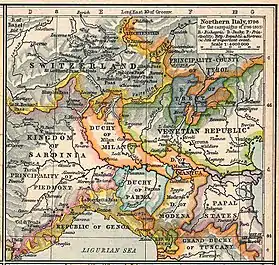Margraviate of Mantua
The Marquisate or Margraviate of Mantua was a margraviate in Lombardy, Northern Italy. Constituted by the Capitano del popolo, an administrative title used in Italy during the Middle Ages.
Margraviate of Mantua | |||||||||
|---|---|---|---|---|---|---|---|---|---|
| 1433–1530 | |||||||||
.svg.png.webp) Flag
.svg.png.webp) Coat of arms
| |||||||||
 Northern Italy in 1796; the Duchy of Mantua can be seen centre-right, shaded in orange, as part of the Duchy of Milan. | |||||||||
| Status | Margravate | ||||||||
| Capital | Mantua | ||||||||
| Common languages | Lombard – Italian | ||||||||
| Religion | Roman Catholicism | ||||||||
| Government | Feudal monarchy | ||||||||
| Margrave of Mantua | |||||||||
• 1433–1444 | Gianfrancesco I (first) | ||||||||
• 1444–1478 | Ludovico II | ||||||||
• 1478–1484 | Federico I | ||||||||
• 1484–1519 | Francesco II | ||||||||
• 1519–1530 | Federico II (last) | ||||||||
| Historical era | Early Modern | ||||||||
| 16 August 1328 | |||||||||
| 22 September 1433 | |||||||||
| 8 April 1530 1530 | |||||||||
| Currency | Zecca di Mantova | ||||||||
| |||||||||
The Marquisate of Mantua began with Gianfrancesco I Gonzaga, a member of the important House of Gonzaga, who inherited the city of Mantua in 1407, when he was only 12 years old.[1]
History
The 9th century was the period of episcopal supremacy, and in the 11th the city formed part of the vast possessions of Bonifacio III, marquis of Canossa. From him it passed to Geoffrey, duke of Lorraine, and afterwards to the countess Matilda, whose support of the pope led to the conquest of Mantua by the emperor Henry IV in 1090. Reduced to obedience by Matilda in 1113, the city obtained its liberty on her death, and instituted a communal government of its own, salva imperiali justitia. It afterwards joined the Lombard League; and the unsuccessful attack made by Frederick II in 1236 brought it a confirmation of its privileges. But after a period of internal discord Ludovico Gonzaga attained to power (1328), and was recognized as imperial vicar (1329); and from that time till the death of Ferdinando Carlo in 1708 the Gonzagas were masters of Mantua under Gian Francesco II, the first Margrave, Ludovico III, Gian Francesco II (whose wife was Isabella d'Este), and Federico II, the first duke of Mantua, the city rose rapidly into importance as a seat of industry and culture. It was stormed and sacked by the Austrians in 1630, and never quite recovered.
Lords of Mantua
People's Captains
- Ludovico I (ruled 1328–60)
- Guido (ruled 1360–69), son of Ludovico
- Ludovico II (1369–82), son of Guido
- Francesco I (ruled 1382–1407), son of Ludovico II
- Gianfrancesco (ruled as Lord 1407–1433), son of Francesco I
Margraves of Mantua
- Gianfrancesco, ruled as the first Margrave (1433–1444)
- Ludovico III (ruled 1444–78), son of Gianfrancesco
- Federico I (ruled 1478–84), son of Ludovico III
- Francesco II (ruled 1484–1519), son of Federico I
- Federico II (ruled as Margrave 1519–1530), son of Francesco II
References
- "Biblioteca Digitale Teresiana - Storia di Mantova". digilib.bibliotecateresiana.it. Retrieved 2020-07-01.